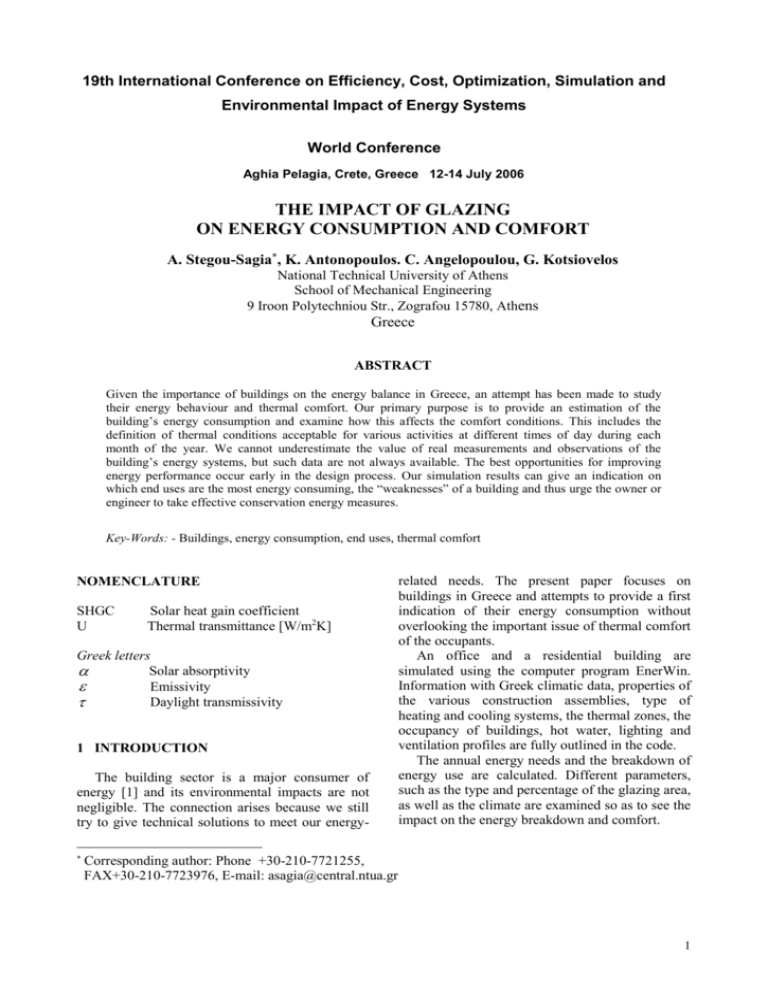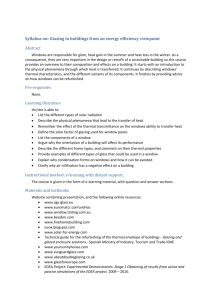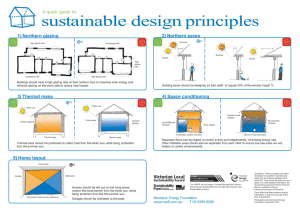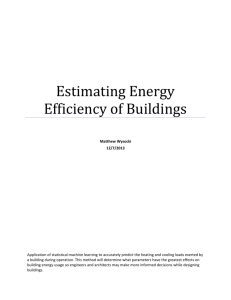Office building
advertisement

19th International Conference on Efficiency, Cost, Optimization, Simulation and
Environmental Impact of Energy Systems
World Conference
Aghia Pelagia, Crete, Greece 12-14 July 2006
THE IMPACT OF GLAZING
ON ENERGY CONSUMPTION AND COMFORT
A. Stegou-Sagia*, K. Antonopoulos. C. Angelopoulou, G. Kotsiovelos
National Technical University of Athens
School of Mechanical Engineering
9 Iroon Polytechniou Str., Zografou 15780, Athens
Greece
ABSTRACT
Given the importance of buildings on the energy balance in Greece, an attempt has been made to study
their energy behaviour and thermal comfort. Our primary purpose is to provide an estimation of the
building’s energy consumption and examine how this affects the comfort conditions. This includes the
definition of thermal conditions acceptable for various activities at different times of day during each
month of the year. We cannot underestimate the value of real measurements and observations of the
building’s energy systems, but such data are not always available. The best opportunities for improving
energy performance occur early in the design process. Our simulation results can give an indication on
which end uses are the most energy consuming, the “weaknesses” of a building and thus urge the owner or
engineer to take effective conservation energy measures.
Key-Words: - Buildings, energy consumption, end uses, thermal comfort
NOMENCLATURE
SHGC
U
Solar heat gain coefficient
Thermal transmittance [W/m2K]
Greek letters
Solar absorptivity
Emissivity
Daylight transmissivity
1 INTRODUCTION
The building sector is a major consumer of
energy [1] and its environmental impacts are not
negligible. The connection arises because we still
try to give technical solutions to meet our energy*
related needs. The present paper focuses on
buildings in Greece and attempts to provide a first
indication of their energy consumption without
overlooking the important issue of thermal comfort
of the occupants.
An office and a residential building are
simulated using the computer program EnerWin.
Information with Greek climatic data, properties of
the various construction assemblies, type of
heating and cooling systems, the thermal zones, the
occupancy of buildings, hot water, lighting and
ventilation profiles are fully outlined in the code.
The annual energy needs and the breakdown of
energy use are calculated. Different parameters,
such as the type and percentage of the glazing area,
as well as the climate are examined so as to see the
impact on the energy breakdown and comfort.
Corresponding author: Phone +30-210-7721255,
FAX+30-210-7723976, E-mail: asagia@central.ntua.gr
1
Moreover, we will attempt to examine whether
comfort conditions in typical Greek buildings
comply with international standards and discuss
the particularities of Greek people as far as thermal
comfort, energy use and behavior is concerned.
2 MODELING METHODOLOGY
The energy interactions between heating,
cooling and lighting of a building are quite
complex and the process of modeling of such a
system requires many input parameters. The
structure of computer program EnerWin allow the
prediction of annual energy consumption per
square meter of floor area as a function of the local
climatic conditions, the building’s geometry and
orientation, the area and type of glazing, the
obstructions due to adjacent buildings and the
quality level of indoor conditions. The potential of
the building’s envelope to control heat and light
entering the building is realized.
Office buildings consume large amounts of
energy within the commercial sector and as they
have specific and homogeneous energy needs, it is
easier to study and apply conservation measures.
According to National Statistical Service of
Greece [2] 75% of the total number of buildings
are residencies.
An office and a residential building were
simulated; the two buildings considered here are
average for these types of buildings, as far as their
size and shape is concerned.
It should be emphasized that real buildings’
layouts were used.
The office building has three floors; the area of
each is 390 m2. Window openings represent 20%
of the total wall area.
Residential building
A new Greek urban building is introduced with
three floors and one apartment on each floor. The
floor area is 139 m2, with the ground floor being a
garage.
(a)
(b)
Figure 2. (a) Sketch of the apartment house. b)
Layout of the typical floor.
2.1
Figure1. Layout of the office building’s typical
floor
Basic input data
The basic input data of the thermal simulation
are:
● Local climatic conditions. They include
ambient temperatures, solar radiation data as well
as wind speed [3-6].
Office building
2
● Geometry and building orientation. Thermal
zoning of the building. that is the selection of
spaces where similar conditions dominate.
● Wall, floor and roof materials and properties.
The typical external wall of a Greek multi-storey
building is 26 cm thick and has the following
properties: thermal transmittance U=0.66 W/m2K,
solar absorptivity =0.75 [7, 8]. Accordingly, the
roof has U=0.397 W/m2K, =0.80 and the floor
U=0.568 W/m2K, =0 [6].
● External shading. No external shading is
assumed.
(a)
(b)
Figure 3. Occupancy profiles (%) [6]: for the office
building {(a)} and the apartment house {(b)}.
● Window properties. The office building has
grey tinted double-glazed windows (25 mm), with
properties U=2.839 W/m2K, solar heating gain
coefficient SHGC=0.47, emissivity 0.84,
daylight transmissivity =0.39. In the apartment
house the windows are double-glazed (25mm),
transparent with U=2.839 W/m2C, solar heating
gain coefficient SHGC=0.75, emissivity =0.60,
daylight transmissivity =0.77 [6, 9]. It is noted
that the SHGC is the percentage of the incident
solar radiation which turns into heat gain inside the
space and it is defined as: SHGC
n
N
k 1
k
ak ,
with N being the inward-flowing fraction of
absorbed radiation in the k layer.
● Heating system: It is assumed that the office
and the residential building use central heating
system with oil as fuel. This is very common in
Greek multi-storey buildings. The efficiency of the
heating system is 85% [10].
● Air conditioning system: The office building
has a central VAV (Variable Air Volume) air
conditioning system. Its coefficient of performance
is 2.60, but its value is adjusted, according to the
ambient temperature and humidity. It is noted that
according to the philosophy of the program, all the
spaces of the building are air conditioned. For the
apartment house we have direct expansion split
units. The coefficient of performance is 2.50, but
its value is adjusted, according to the ambient
temperature and humidity.
● The maximum number of people expected to
occupy each zone, as well as the occupancy profile
of the zone: The profile contains 24 hourly values
that describe the average daily occupancy pattern.
We have assumed 10 persons/100 m2 according
to the indication of the guide of the Greek
Technical Chamber [11] for our office building.
● The average number of volume units of hot
water used per person per occupied day, which is
3.8 lit/day/person for the office building and 35
lit/day/person for the house [6]. Values represent
the hourly percentage of total daily use.
● Natural ventilation. The opening of windows
from the occupants, when the space is too warm is
a common practice in residencies but this
parameter simulating the natural ventilation is not
taken into account for the office building.
● Lighting and electrical equipment [6, 12]. In
the house incandescent lamps are used, while in
the office building we have assumed fluorescent
type for lighting sources. The equipment refers to
any kind of electrical device, for example
refrigerators, computers etc.
● Space temperature. Temperature is allowed to
shift between set limits. Temperatures are those
that exist in a building and are neither the desired
ones nor the design temperatures. This is for
simulating the real situation, and allows seeing
what the comfort conditions are. The temperature
range is set to be between 20 to 27oC.
It is stressed that the program sizes both the
heating and cooling systems according to the
existing load, the thermostat settings and the
3
system’s efficiency. By setting the temperature to
shift in a range representing the real temperatures
in the interior [13] we can estimate the actual
energy consumption and examine what comfort
conditions are achieved.
a northern Greek city, Thessalonica.
A demanding task for an architect is to design a
building according to different outside conditions
in such a way that the indoor environment remains
within the occupants’ comfort range. For this
reason and as a first attempt, the apartment house
has been simulated with double-glazed windows
and single plate ones [9]. Furthermore, calculations
have been performed to study the climate effect.
Our results are presented hereafter.
3 RESULTS
3.1 Building’s energy performance
(a)
We can observe in Table 1 that the total annual
energy consumption in office building reaches its
highest value with clear glazing, due to the
increased solar gains. Less glazing area reduces
energy use, while the grey tinted glazing offers a
balanced solution.
Table 1. Total annual energy consumption for the
office building in Athens
Type of glazing: double
(b)
Figure 4. Hot water profile (%) [6]: for the
office building {(a)} and the apartment house {(b)}
2.2 Parametrical study and the type of
variables
Glazing plays an important role in office and
residential buildings. It provides view, daylight,
but can also increase energy consumption due to its
poor insulation value. An attempt has been made to
examine the impact of glazing on energy
consumption and comfort.
The office building has originally double glazed
grey tinted windows which represents 20% of the
total wall area.
- The building was then simulated using
double glazed clear glazing.
- It was eventually simulated after reducing
the glazing area to 10% of the wall area.
- Finally, in order to examine the effect of the
climate, the building was supposed to be located in
Grey tinted glazing
Clear glazing
Reduced glazing
area (10% of wall area)
Total annual energy
consumption
1714.5 MJ/m2
1894.0 MJ/m2
1613.5 MJ/m2
Table 2. Total annual energy consumption for
the office building in Thessalonica
Type of glazing: double
Grey tinted glazing
Clear glazing
Reduced glazing
area (10% of wall area)
Total annual energy
consumption
1741.8 MJ/m2
1863.9 MJ/m2
1615.7 MJ/m2
The climate does not seem to have an important
impact on the total annual consumption, as we can
extract from Table 2.
The breakdown of energy use is presented in
the following. The main uses are space heating and
cooling, hot water use, lighting and building
equipment.
4
Thessaloniki
Athens
space heating
18%
equipment
22%
space heating
9%
equipment
24%
space cooling.
25%
space cooling.
20%
lighting
37%
hot water
3%
lighting
39%
(a)
Athens
(a)
space heating
15%
equipment
22%
space heating
7%
equipment
24%
hot water
3%
Thessaloniki
space cooling.
29%
space cooling.
25%
lighting
35%
hot water
3%
lighting
37%
Thessaloniki
(b)
Athens
(b)
space heating
20%
equipment
22%
space heating
11%
equipment
24%
hot water
3%
space cooling.
20%
hot water
4%
lighting
41%
(c)
Figure 5. Breakdown to end uses for the office
building in Athens for (a) double, grey tinted
glazing, (b) double, clear glazing and (c) reduced
glazing area to 10% of wall area
According to Figures 5 and 6, the main use in
the office building is the lighting. It is common
practice in commercial buildings to have the lights
on during the whole day.
Although the climate does not have a
considerable effect on the annual consumption, it
affects the distribution to the end uses. More space
heating energy is required, as a result of the lower
winter temperatures observed in the city of
Thessalonica.
space cooling.
16%
lighting
38%
hot water
4%
(c)
Figure 6. End uses for the office building in
Thessalonica (a) double, grey tinted glazing, (b)
double, clear glazing and (c) reduced glazing area
to 10% of wall area
With the use of clear glass the solar heat gains
increase and therefore there is a reduction in space
heating energy and an increase in cooling energy.
The reduced glazing area, reduces consumption,
but it has a negative impact on the use of artificial
lighting.
In the apartment house the fundamental
objective is to maintain acceptable levels of
interior comfort day and night, all year round.
Therefore the knowledge of the occupants’
requirements and the architectural concepts must
be combined in a sensitive way. The use of natural
daylight can bring significant advantages in cost
savings, reducing cooling loads created by
artificial lighting and the consequent atmospheric
pollution as well as contributing to a healthier
5
living and working environment. Good daylighting
design is inseparable from good architectural
design. For this reason, and because of the fact that
this is a first attempt to study further the selected
apartment house, we give in Figure 7 the reduction
of thermal losses by using double glazing instead
of single plate windows [6, 9].
(a)
Figure 7. The reduction of thermal losses by
using double glazing instead of single plate
windows [6, 9] for the apartment house’s typical
floor
(b)
Figure 9. Energy use in the apartment house in
Thessalonica for: (a) double glazed transparent
windows, (b) single plate glazing.
The Figures 8 and 9 illustrate the percentage
breakdown of energy use in the apartment house.
As we can see the results for heating energy and
cooling are influenced from the impacts of climate.
3.2 Thermal comfort aspects
International comfort standards are based on
energy balance models (static models). ASHRAE
defines that the comfort conditions in terms of
operative temperature values range from 20 to
27oC.
The conditions proposed from ASHRAE have
been used as the comfort zone [13, 14].
Figure 10. ASHRAE comfort zone.
According to the conditions that exist inside the
building, the diagrams below show for what
percentage of time each month comfort conditions
indicated by ASHRAE dominate.
Figure 8. Energy use in the apartment house in
Athens for double glazed transparent windows
6
Athens
Percentage of time with
comfort conditions [%]
100
80
60
40
20
0
Jan Feb Mar Apr May Jun Jul Aug Sep Oct Nov Dec
(a)
Athens
(a)
Percentage of time with
comfort conditions [%]
100
80
60
40
20
0
Jan Feb Mar Apr May Jun Jul Aug Sep Oct Nov Dec
(b)
Athens
(b)
Percentage of time with
comfort conditions [%]
100
Figure 12. Percentage of time with comfort
conditions inside the apartment house with doubleglazed transparent windows in (a) Athens and in
(b) Thessalonica.
80
60
40
20
0
Jan Feb Mar Apr May Jun Jul Aug Sep Oct Nov Dec
(c)
Figure 11. Percentage of time with comfort
conditions for the office building in Athens for (a)
double, grey tinted glazing, (b) double, clear
glazing and (c) reduced glazing area to 10% of
wall area
The problem of thermal discomfort is
concentrated on the summer months. During
winter months the problem is not so intense.
According to the standards, it seems that for a
large percentage of time on yearly basis, there is
discomfort inside Greek buildings. This is only
partially true. On the one hand, there is room for
better use of energy as well as improvement of
thermal comfort in Greek residencies. On the other
hand, a number of factors concerning the
occupants’ behaviour [15] indicate that the results
regarding thermal comfort are overestimated:
● The thermal sensation can affect energy
consumption, but it cannot be easily measured or
taken into consideration in case of thermal
simulation, designing, etc. International standards
can act as guiding lines, but they cannot, however,
be approached globally. Especially in the case of
the Mediterranean climate, the tolerance in higher
temperatures is given. While, for example the
standard indicates that 28oC is outside the comfort
zone, a resident in Greece would find the
conditions acceptable.
● An important factor influencing thermal
comfort is the length of stay in a space, which
causes the adaptation of settings of the
physiological thermoregulation system. In other
words, the occupant is acclimatized and responds
to expected conditions.
● Another parameter has to do with perceived
control of the occupants. A person is more tolerant
to climatic changes when s/he feels s/he has
control over the indoor environment. Usually, in
offices this is not the case. The user has no
personal control and that can lead to increased
energy consumption.
7
The changes in the type of glazing and the
percentage of openings don’t seem to have an
important impact on thermal comfort. We have not
considered, however for the office building, the
effect of windows on visual comfort of the
occupants. Fewer windows reduce the energy use
of the building, but may have a negative impact on
the users (disconnection with the natural
environment, lack of view, etc). As we have
already mentioned this is the main reason for not
reducing the glazing area in the apartment house.
CONCLUSION
The choice for glazing is an important factor in
office and residential buildings, because it affects
directly the energy consumption.
Our simulation results have shown that there is
room for saving energy, especially for lighting, in
Greek office buildings.
In Greece the problem of thermal comfort is
focused in summertime, mostly due to the climate,
but also because the majority of building designers
do not lay importance on lighting and cooling. The
same pattern is observed throughout the year for all
cases and only minor changes were observed due
to the glazing parameters. A point of interest in
office buildings is the perceived control of the
occupants. If taken into consideration, it can
reduce energy consumption.
In all, action, through careful designing, has to
take place so that both comfort and energy
conservation is achieved.
REFERENCES
[1] Iatridis M. Energy Efficiency in Greece,
Report, Centre for Renewable Energy
Sources, SAVE Project, 2003.
[2] Statistical Yearbook of Greece 1996. National
[5] Kouremenos D.A., Antonopoulos K.A. A
Daily Variation Model for the Outdoor
Temperature and Relative Humidity in
Athens/Greece. In Proceedings of the
International ASME Conference on Modelling
and Simulation, Sorrento, Italy, Sep. 29-Oct.
1, 1986, Vol. 4.1-3, p. 77-88.
[6] Degelman L.O. Ener-Win 97.2000, User’s
Manual, 2002.
[7] Koronaki E.P. Dynamic Thermal Characteristics of Buildings. Doctoral Thesis, National
Technical University of Athens, 2000.
[8] Antonopoulos K.A., Tzivanidis C. Time
Constant of Greek Buildings. Energy, 1995;
20 (8): 789-802.
[9] Presidential Decree: On the Approval of
Thermal Insulation for Buildings. The
Government Gazette, Issue 4, no. 362,
4/7/1979.
[10] Presidential Decree no. 335: Demands in
Efficiency for New Hot Water Boilers
Supplied with Liquid or Air Fuel, in
Compliance with the Directive of the Council
of the European Community 92/42/EEC of the
21st May 1992 (L167/92). The Government
Gazette, Issue 1, no. 143, 2/9/1993.
[11] Technical Chamber of Greece. Elements for
Calculating Cooling Loads in Buildings.
Technical Guide no. 2425/86, 2002.
[12] CIBSE. Energy Use in Offices. Energy
Consumption Guide 19, 2000.
[13] Hays S.M., Gobbell R.V., Ganick, N. R.
Indoor Air Quality. Solutions and Strategies.
New York: McGraw-Hill, Inc. 1995.
[14] ASHRAE, Fundamentals Handbook, 1997
[15] Brager G.S., de Dear R.J. Thermal Adaptation
in the Built Environment: A Literature
Review. Energy and Buildings, 1998; 27: 8396.
Statistical Service of Greece, 1997.
[3] Kouremenos D.A., Antonopoulos K.A.,
Domazakis E.S. Solar Radiation Correlations
for the Athens, Greece, Area. Solar Energy
1985; 35: 259-269.
[4] Kouremenos D.A., Antonopoulos K.A.
Numerical
Determination
of
Relative
Humidity and Dry Bulb Temperature in
Greece from Meteorological Observations. In
Proceedings of the 4th International
Conference on Numerical Methods in
Laminar and Turbulent flow, Swansea, UK,
July 9-12, 1985, Part 2, p.1709-1720.
8







